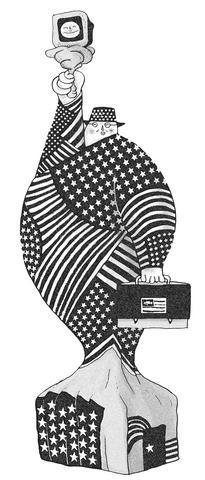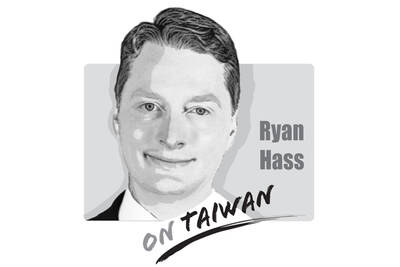News that US President George W. Bush intended to support the continuation of Alan Greenspan as chairman of the Federal Reserve Board of Governors was greeted with wide support. However, if Greenspan cares about his place in history, he might be wise to decline the offer.
As it is, Greenspan's reign as chairman of the Fed will be remembered for the asset bubbles that occurred during his watch. His departure as monetary helmsman for the world's largest economy should be sooner rather than later so that the burden of blame for a pair of other bubbles falls on his successor.

ILLUSTRATION: MOUNTAIN PEOPLE
The first Greenspan bubble was the dot-com boom that collapsed into what is likely to become known as the Great Correction for its intensity and longevity. Despite noting the irrational exuberance at work in stock markets, he opened the credit taps in 1998 and allowed things to really get out of hand. After two mostly-bearish years, the Dow Jones average never went below the level when this famous utterance was made.
Now loose monetary policy and the artificially-low interest rates it brought have helped generate a double bubble in the housing and bond markets. If either of these doppelgangers blows up, the US economy could be blown out of the water. That would certainly be a hit below the water line for the global economy.
First, consider the housing sector. After adjusting for inflation, housing prices are up 28 percent in the US since 1996. Following an increase of 11 percent in 2001, US home prices rose by 7 percent in the year-to-December 2002. Since the actions of US monetary authorities influence interest rates elsewhere, house-price inflation is evident in other industrialized countries where such data are collected.
With mortgage rates at a 40-year low of 6 percent, they are more likely to rise than fall. Lower mortgage rates have been driving demand for housing that has caused an upward drift in home values. Higher prices have caused property tax bills to rise, making them the second largest expense for homeowners after their mortgage payments. Last year, Americans made interest payments of US$265 billion on their homes while paying US$205 billion in property taxes.
As it is, the housing market is vulnerable to a combination of forced sales due to job losses or the inability to make higher mortgage payments when rates rise or the unsustainable burden of taxes. The bad news for those who may wish or are forced to sell is that prospective buyers will bargain for downward adjustments in the asking price to offset the burden of the higher tax assessments. At the same time, higher lending rates may reduce the number of prospective buyers.
Looking to the past, housing bubbles often lead to crashes with price drops on homes that average from 25 to 30 percent. And these upsets have generally been accompanied by large economic contractions.
The prospects of a punctured housing bubble would be bad enough. Now consider the bond market bubble. While stock prices have had three bad years, bonds have had three good years.
Indeed, strong surges in prices have occurred over the past year when investors sought the safety of holding government debt. As a flood of new bonds are sold this year due to tightening government finances, those levels may now be untenable.
Like bad things, few good things cannot and do not last forever. The forces of supply and demand will ultimately push bond prices down. Additional pressures will be put on bond prices if taxes are eliminated on stock dividends and investors respond by putting more funds back in equity markets.
With investors attempting to find safe investment vehicles during the slowdown, the price of government bonds has been bid up so that interest rates have been driven down. Similarly, investors have been encouraged to buy bonds on expectations that a policy of low interest rates will be followed for the foreseeable future. As it is, the rising demand behind the bond bubble is caused by the loose monetary policy of the Fed has put excess liquidity into the system. And so it is that monetary easing has made the yields on government bonds more volatile.
Greenspan's debt bubble is not limited to the US. The market in emerging-market debt is staging a remarkably strong rally that will inevitably end in tears with a bust in debt prices. Over the past 12 months, the average rate of returns on emerging-market debt funds has been 21 percent. Rising from a low of 7.3 percentage points over US Treasuries prior to the Brazilian presidential election in October last year, average debt spreads are now about 4.3 percentage points over benchmark American government securities.
Unfortunately, these improvements have occurred without any changes in the fundamentals for the main emerging-market economies. Consider the situation in some of the most important emerging-market economies. For example, Brazil's vast domestic and external debt burden remains just as unsustainable since its economy remains mired in slow growth. And many of its Latin American neighbors have become afflicted with political instability.
In Turkey, domestic political issues have diverted energies that might have boosted reform. Meanwhile, central European economies are waiting on Godot in the form of a resilient German economy.
Emerging-market debt prices have benefited from the worsening of the overall global economic environment. This is because declining global interest rates induce investors to shift assets out of equities and into fixed income funds like the higher-yielding debt issued in emerging-market economies. In turn, bidding for debt causes prices to rise and attracts more funds due to the prospects of capital gains.
There will be an inevitable correction in prices for debt issued in emerging-market economies. It will occur when central banks tighten up on global liquidity or when the reality of the effects of the global slowdown begin to bump up against weak economic fundamentals.
Then the true legacy of the Greenspan years will come to haunt. Better that he quits now before his legacy is completely tainted.
Christopher Lingle is global strategist for eConoLytics.com and professor of economics at Universidad Francisco Marroqu in Guatemala.

China has not been a top-tier issue for much of the second Trump administration. Instead, Trump has focused considerable energy on Ukraine, Israel, Iran, and defending America’s borders. At home, Trump has been busy passing an overhaul to America’s tax system, deporting unlawful immigrants, and targeting his political enemies. More recently, he has been consumed by the fallout of a political scandal involving his past relationship with a disgraced sex offender. When the administration has focused on China, there has not been a consistent throughline in its approach or its public statements. This lack of overarching narrative likely reflects a combination
US President Donald Trump’s alleged request that Taiwanese President William Lai (賴清德) not stop in New York while traveling to three of Taiwan’s diplomatic allies, after his administration also rescheduled a visit to Washington by the minister of national defense, sets an unwise precedent and risks locking the US into a trajectory of either direct conflict with the People’s Republic of China (PRC) or capitulation to it over Taiwan. Taiwanese authorities have said that no plans to request a stopover in the US had been submitted to Washington, but Trump shared a direct call with Chinese President Xi Jinping (習近平)
Heavy rains over the past week have overwhelmed southern and central Taiwan, with flooding, landslides, road closures, damage to property and the evacuations of thousands of people. Schools and offices were closed in some areas due to the deluge throughout the week. The heavy downpours brought by the southwest monsoon are a second blow to a region still recovering from last month’s Typhoon Danas. Strong winds and significant rain from the storm inflicted more than NT$2.6 billion (US$86.6 million) in agricultural losses, and damaged more than 23,000 roofs and a record high of nearly 2,500 utility poles, causing power outages. As
The greatest pressure Taiwan has faced in negotiations stems from its continuously growing trade surplus with the US. Taiwan’s trade surplus with the US reached an unprecedented high last year, surging by 54.6 percent from the previous year and placing it among the top six countries with which the US has a trade deficit. The figures became Washington’s primary reason for adopting its firm stance and demanding substantial concessions from Taipei, which put Taiwan at somewhat of a disadvantage at the negotiating table. Taiwan’s most crucial bargaining chip is undoubtedly its key position in the global semiconductor supply chain, which led